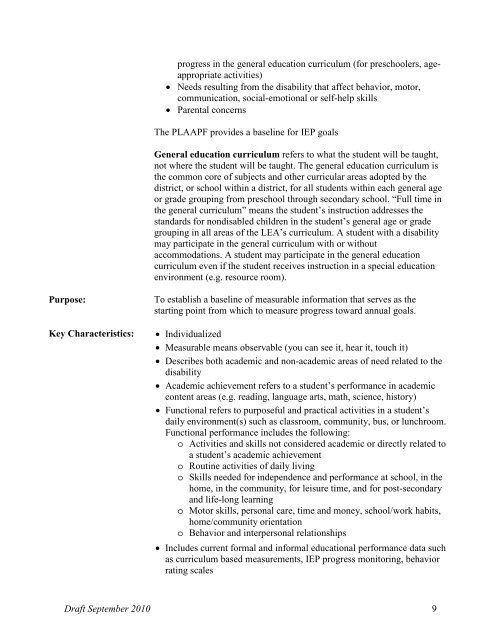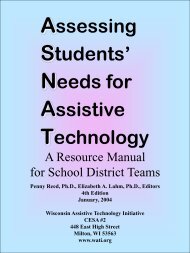Guide for Writing IEPs - The Special Education Team - Wisconsin.gov
Guide for Writing IEPs - The Special Education Team - Wisconsin.gov
Guide for Writing IEPs - The Special Education Team - Wisconsin.gov
You also want an ePaper? Increase the reach of your titles
YUMPU automatically turns print PDFs into web optimized ePapers that Google loves.
progress in the general education curriculum (<strong>for</strong> preschoolers, ageappropriate<br />
activities)<br />
• Needs resulting from the disability that affect behavior, motor,<br />
communication, social-emotional or self-help skills<br />
• Parental concerns<br />
<strong>The</strong> PLAAPF provides a baseline <strong>for</strong> IEP goals<br />
General education curriculum refers to what the student will be taught,<br />
not where the student will be taught. <strong>The</strong> general education curriculum is<br />
the common core of subjects and other curricular areas adopted by the<br />
district, or school within a district, <strong>for</strong> all students within each general age<br />
or grade grouping from preschool through secondary school. “Full time in<br />
the general curriculum” means the student’s instruction addresses the<br />
standards <strong>for</strong> nondisabled children in the student’s general age or grade<br />
grouping in all areas of the LEA’s curriculum. A student with a disability<br />
may participate in the general curriculum with or without<br />
accommodations. A student may participate in the general education<br />
curriculum even if the student receives instruction in a special education<br />
environment (e.g. resource room).<br />
Purpose: To establish a baseline of measurable in<strong>for</strong>mation that serves as the<br />
starting point from which to measure progress toward annual goals.<br />
Key Characteristics: • Individualized<br />
• Measurable means observable (you can see it, hear it, touch it)<br />
• Describes both academic and non-academic areas of need related to the<br />
disability<br />
• Academic achievement refers to a student’s per<strong>for</strong>mance in academic<br />
content areas (e.g. reading, language arts, math, science, history)<br />
• Functional refers to purposeful and practical activities in a student’s<br />
daily environment(s) such as classroom, community, bus, or lunchroom.<br />
Functional per<strong>for</strong>mance includes the following:<br />
o Activities and skills not considered academic or directly related to<br />
a student’s academic achievement<br />
o Routine activities of daily living<br />
o Skills needed <strong>for</strong> independence and per<strong>for</strong>mance at school, in the<br />
home, in the community, <strong>for</strong> leisure time, and <strong>for</strong> post-secondary<br />
and life-long learning<br />
o Motor skills, personal care, time and money, school/work habits,<br />
home/community orientation<br />
o Behavior and interpersonal relationships<br />
• Includes current <strong>for</strong>mal and in<strong>for</strong>mal educational per<strong>for</strong>mance data such<br />
as curriculum based measurements, IEP progress monitoring, behavior<br />
rating scales<br />
Draft September 2010 9











